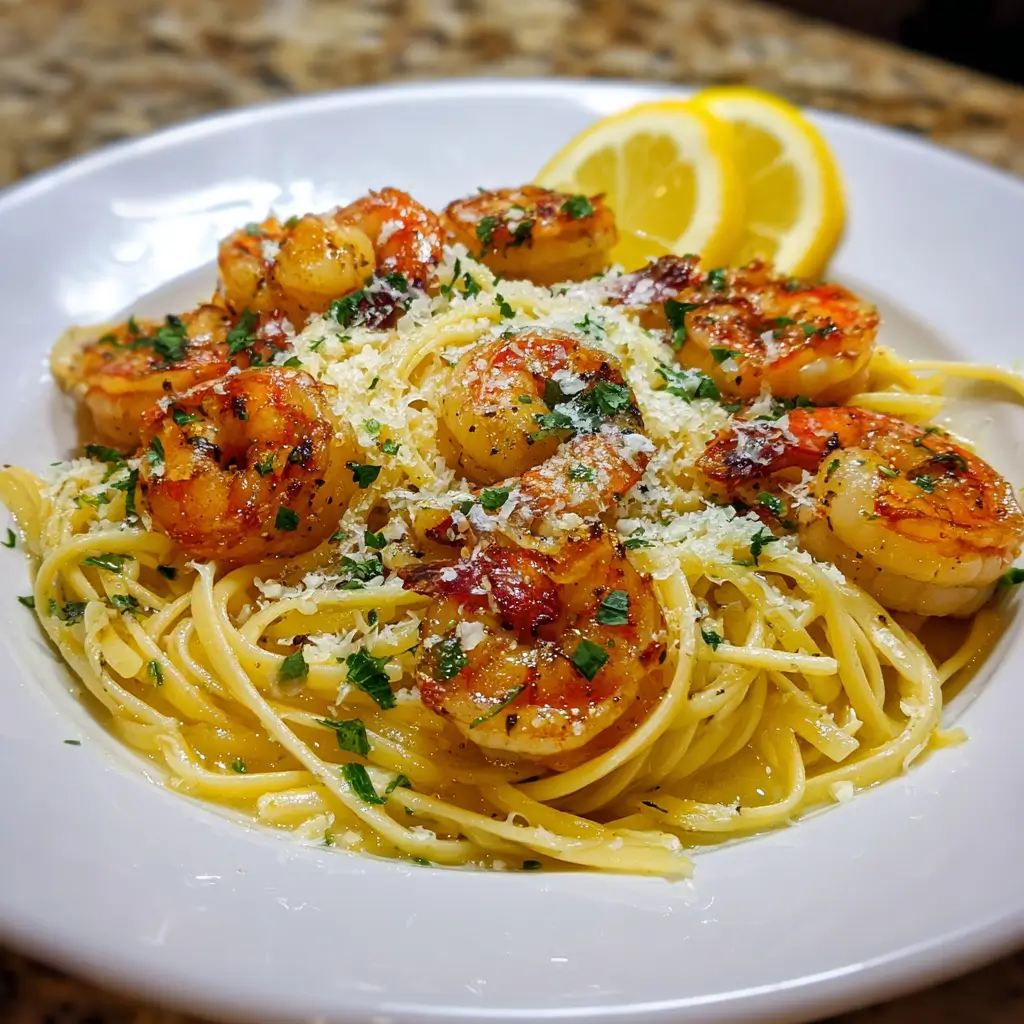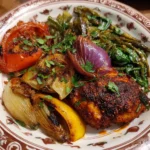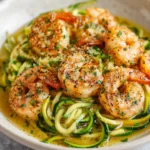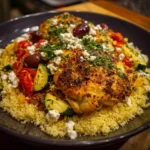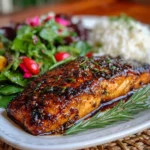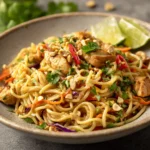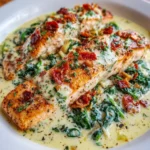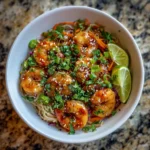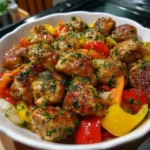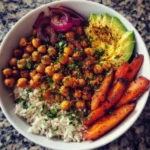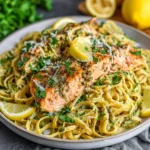Lemon Butter Garlic Shrimp Pasta: A Zesty, Creamy Delight
The Lemon Butter Garlic Shrimp Pasta is a culinary masterpiece that brings together the bright tang of lemon, the rich depth of butter, the aromatic punch of garlic, and the delicate sweetness of fresh shrimp. This dish has become a favorite in both home kitchens and upscale restaurants for its elegant balance of flavors and quick preparation time. Whether you’re cooking for a romantic dinner or a weeknight family meal, this recipe delivers restaurant-quality results with minimal effort. Its vibrant color, intoxicating aroma, and luxurious texture make it an irresistible choice for seafood lovers and pasta enthusiasts alike.
The History
Pasta dishes featuring seafood have roots stretching back centuries across Mediterranean cuisine. In Italy, coastal regions like Sicily and Campania have long incorporated fresh fish and shellfish into their pasta traditions, using simple yet flavorful ingredients such as olive oil, garlic, tomatoes, and herbs. The concept of pairing shrimp with garlic and lemon likely evolved from these regional Italian practices, particularly spaghetti ai frutti di mare (seafood spaghetti) and spaghetti aglio e olio (garlic and oil). Over time, American-Italian fusion cuisine embraced richer elements like butter and cream, giving rise to modern variations such as Lemon Butter Garlic Shrimp Pasta. This version combines Old World simplicity with New World indulgence, creating a creamy, zesty dish that’s now a staple in contemporary Western cooking. Its popularity surged in the 2000s with the rise of food blogs and cooking shows, where chefs showcased how easy it was to elevate basic ingredients into something extraordinary.
Ingredients Breakdown
The magic of this dish lies in the harmony of its components. Each ingredient plays a vital role:
- Fresh Shrimp: Preferably medium to large (26/30 count), peeled and deveined. Freshness ensures a sweet, tender bite. You can use wild-caught or sustainably farmed shrimp.
- Lemon: Both zest and juice are used. The zest adds intense citrus fragrance without acidity, while the juice provides a bright, refreshing tang that cuts through the richness.
- Butter: Unsalted butter is preferred for better control over seasoning. It forms the base of the sauce, lending silkiness and mouthfeel. For extra richness, some recipes include browned butter.
- Garlic: Freshly minced garlic is essential—its pungent aroma mellows when sautéed, infusing the entire dish with savory depth.
- Olive Oil: Used alongside butter to prevent burning and add a fruity undertone. Extra virgin olive oil enhances flavor.
- Pasta: Linguine is traditional due to its ability to hold sauces well, but fettuccine, spaghetti, or even angel hair work beautifully.
- Heavy Cream or Parmesan: Optional additions for a creamier texture. Heavy cream makes the sauce luxuriously smooth, while grated Parmesan adds umami and helps emulsify the sauce.
- White Wine: Dry white wine (like Pinot Grigio or Sauvignon Blanc) deglazes the pan and introduces subtle acidity and complexity.
- Salt & Pepper: Crucial for balancing flavors. Season in layers—for best results, salt both the shrimp and the pasta water.
- Red Pepper Flakes: A pinch adds gentle heat that complements the citrus and seafood.
- Fresh Herbs: Parsley (flat-leaf) is most common, adding freshness and color. Basil or chives can be used for variation.
- Grated Parmesan Cheese: Though not always included in seafood pastas (some purists avoid cheese with fish), many enjoy the added savoriness it brings.
Step-by-Step Recipe
- Prepare Ingredients: Mince 4–5 cloves of garlic. Zest one lemon and juice two (you’ll need about 1/3 cup juice). Chop a handful of fresh parsley. Peel and devein 1 pound of raw shrimp; pat them dry and season lightly with salt and pepper.
- Cook the Pasta: Bring a large pot of salted water to a boil (use about 1 tablespoon of salt per quart of water). Add 8 ounces of linguine and cook until al dente (usually 8–10 minutes). Reserve 1 cup of pasta water before draining.
- Sear the Shrimp: While the pasta cooks, heat 2 tablespoons of olive oil in a large skillet over medium-high heat. Add the shrimp in a single layer and sear for 1–2 minutes per side until pink and opaque. Remove and set aside.
- Sauté the Aromatics: In the same skillet, reduce heat to medium. Add 3 tablespoons of unsalted butter and let melt. Stir in the minced garlic and a pinch of red pepper flakes. Sauté for 30–60 seconds until fragrant—do not let garlic brown.
- Build the Sauce: Pour in 1/4 cup of dry white wine to deglaze the pan, scraping up any browned bits. Let it simmer for 1–2 minutes until slightly reduced. Add the lemon juice and zest, stirring to combine.
- Enrich the Sauce (Optional): For a creamier texture, stir in 1/4 cup of heavy cream or 1/3 cup of grated Parmesan cheese. Simmer gently for another 1–2 minutes until the sauce thickens slightly.
- Combine Everything: Add the drained pasta to the skillet and toss to coat evenly. Add the cooked shrimp back in. If the sauce seems too thick, gradually add reserved pasta water, 1/4 cup at a time, until the desired consistency is reached.
- Finish and Serve: Stir in half the chopped parsley. Taste and adjust seasoning with salt, pepper, or more lemon juice if needed. Garnish with remaining parsley and additional lemon slices or zest. Serve immediately.
Tips
- Don’t Overcook the Shrimp: They continue to cook slightly after being removed from heat. Overcooked shrimp become rubbery—aim for just opaque.
- Use Fresh Lemon Juice: Bottled lemon juice lacks brightness and can taste flat or artificial.
- Reserve Pasta Water: The starchy liquid helps bind the sauce to the pasta, creating a silky, cohesive dish.
- Prep Ahead: Mince garlic, chop herbs, and zest/juice lemons before starting. This dish comes together quickly, so mise en place is key.
- Don’t Crowd the Pan: When searing shrimp, work in batches if necessary to ensure even browning.
- Brown the Butter (Optional Upgrade): For a nutty, deeper flavor, brown the butter before adding garlic. Watch carefully—it burns easily.
- Balance Acidity: If the lemon overwhelms, a tiny pinch of sugar or a splash of cream can mellow the sharpness.
- Serve Immediately: Pasta dishes with butter-based sauces are best enjoyed hot off the stove.
Variations and Customizations
- Spicy Version: Increase red pepper flakes or add a dash of hot sauce like Calabrian chili paste or sriracha.
- Dairy-Free: Replace butter with vegan butter or olive oil, skip cream and cheese, and use nutritional yeast for a cheesy flavor.
- Gluten-Free: Use gluten-free pasta (such as brown rice or chickpea linguine) and ensure all other ingredients are certified GF.
- Add Veggies: Toss in spinach, cherry tomatoes, roasted red peppers, asparagus, or artichoke hearts for added nutrition and color.
- Protein Swaps: Try scallops, chicken breast, or even tofu for different textures.
- Creamy Alfredo Twist: Blend in mascarpone or cream cheese for a decadent, velvety sauce.
- Herb Variations: Substitute parsley with basil for a summery twist, or dill for a Scandinavian flair.
- Wine-Free Option: Skip the wine and use extra chicken or vegetable broth with a splash of vinegar for acidity.
- Low-Carb/Keto: Serve over zucchini noodles (zoodles) or spaghetti squash. Use ghee instead of butter and full-fat cream.
- Asian-Inspired Fusion: Add ginger, soy sauce, sesame oil, and green onions for an East-meets-Mediterranean twist.
Health Considerations and Nutritional Value
Lemon Butter Garlic Shrimp Pasta can be a relatively healthy meal when prepared with mindful ingredient choices. Here’s a breakdown of its nutritional profile (approximate for one serving, based on 4 servings):
- Calories: 450–600 kcal (varies with cream, cheese, and portion size)
- Protein: 25–30g – Shrimp is a lean source of high-quality protein, rich in essential amino acids.
- Fat: 18–25g – Mostly from butter and olive oil. Opting for less butter or using olive oil primarily reduces saturated fat.
- Carbohydrates: 45–55g – Primarily from pasta. Whole grain or legume-based pasta increases fiber content.
- Fiber: 2–4g – Can be increased by adding vegetables or whole grain pasta.
- Vitamins & Minerals: Shrimp provide selenium, vitamin B12, iodine, and phosphorus. Lemon contributes vitamin C and antioxidants. Garlic contains allicin, known for immune-boosting properties.
Health Tips:
- To reduce sodium, use low-sodium butter or limit added salt, relying on herbs and lemon for flavor.
- For heart health, emphasize olive oil over butter and skip heavy cream.
- Shrimp contain cholesterol, but current research suggests dietary cholesterol has less impact on blood cholesterol than once thought. Moderation is still advised for those with specific conditions.
- Ensure shrimp are sustainably sourced—look for certifications like MSC (Marine Stewardship Council).
- This dish is naturally low in carbohydrates compared to many creamy pastas, making it adaptable for various diets with modifications.
Ingredients
- 8 oz (225g) linguine or spaghetti
- 1 lb (450g) large raw shrimp, peeled and deveined
- 3 tbsp unsalted butter
- 2 tbsp extra virgin olive oil
- 5 cloves garlic, minced
- Zest and juice of 2 lemons (about 1/3 cup juice)
- 1/4 cup dry white wine (e.g., Pinot Grigio)
- 1/4 cup heavy cream (optional)
- 1/3 cup grated Parmesan cheese (optional)
- 1/2 tsp red pepper flakes (adjust to taste)
- Salt and freshly ground black pepper, to taste
- 1/2 cup fresh parsley, chopped
- Lemon slices, for garnish
Directions
- Bring a large pot of generously salted water to a boil. Add pasta and cook according to package instructions until al dente. Before draining, reserve 1 cup of pasta water, then drain and set aside.
- Pat shrimp dry with paper towels and season lightly with salt and pepper.
- In a large skillet over medium-high heat, add olive oil. Once hot, add shrimp in a single layer and cook 1–2 minutes per side until pink and just cooked through. Transfer to a plate and set aside.
- In the same skillet, reduce heat to medium. Add butter, garlic, and red pepper flakes. Sauté for 30–60 seconds until fragrant but not browned.
- Pour in white wine to deglaze the pan, scraping up any browned bits. Simmer 1–2 minutes until reduced by half.
- Stir in lemon juice, lemon zest, and optional heavy cream. Simmer gently for 2 minutes to meld flavors.
- If using Parmesan, stir it in now and mix until melted and smooth.
- Add the cooked pasta to the skillet and toss to coat thoroughly. Add the cooked shrimp and gently combine.
- If the sauce is too thick, add reserved pasta water 1/4 cup at a time until desired consistency is achieved.
- Stir in half the chopped parsley. Taste and adjust seasoning with salt, pepper, or more lemon juice.
- Transfer to serving plates, garnish with remaining parsley, lemon slices, and extra Parmesan if desired.
- Serve immediately while hot.
FAQ
Can I use frozen shrimp?
Yes, but thaw them first in cold water or overnight in the refrigerator. Pat dry thoroughly to prevent excess moisture.
Can I make this ahead of time?
Best served fresh, but you can prep ingredients in advance. Cooked shrimp reheats poorly, so consider undercooking slightly and finishing the dish just before serving.
What pasta works best?
Linguine and fettuccine are ideal, but spaghetti, bucatini, or even penne work well. Choose shapes that hold sauce.
Is this dish gluten-free?
Only if you use gluten-free pasta and ensure all other ingredients (especially wine and broth) are certified GF.
Can I omit the wine?
Absolutely. Substitute with chicken or vegetable broth plus 1 teaspoon of white wine vinegar or lemon juice for acidity.
Why did my sauce break or separate?
This can happen if the temperature is too high or there’s insufficient starch. Emulsify by adding warm pasta water slowly while stirring vigorously.
How do I store leftovers?
Store in an airtight container in the refrigerator for up to 2 days. Reheat gently on the stove with a splash of water or broth to revive the sauce.
Can I freeze this dish?
Not recommended. Dairy-based sauces may separate upon freezing, and shrimp can become tough when reheated.
Summary
Lemon Butter Garlic Shrimp Pasta is a vibrant, restaurant-worthy dish that combines succulent shrimp, al dente pasta, and a luscious citrus-garlic sauce in under 30 minutes.
Elegant yet simple, it’s perfect for impressing guests or treating yourself to a gourmet meal with pantry staples and fresh ingredients.
